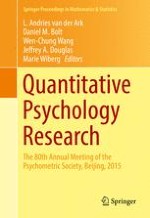2016 | OriginalPaper | Buchkapitel
Using the Asymmetry of Item Characteristic Curves (ICCs) to Learn About Underlying Item Response Processes
verfasst von : Sora Lee, Daniel M. Bolt
Erschienen in: Quantitative Psychology Research
Aktivieren Sie unsere intelligente Suche, um passende Fachinhalte oder Patente zu finden.
Wählen Sie Textabschnitte aus um mit Künstlicher Intelligenz passenden Patente zu finden. powered by
Markieren Sie Textabschnitte, um KI-gestützt weitere passende Inhalte zu finden. powered by
